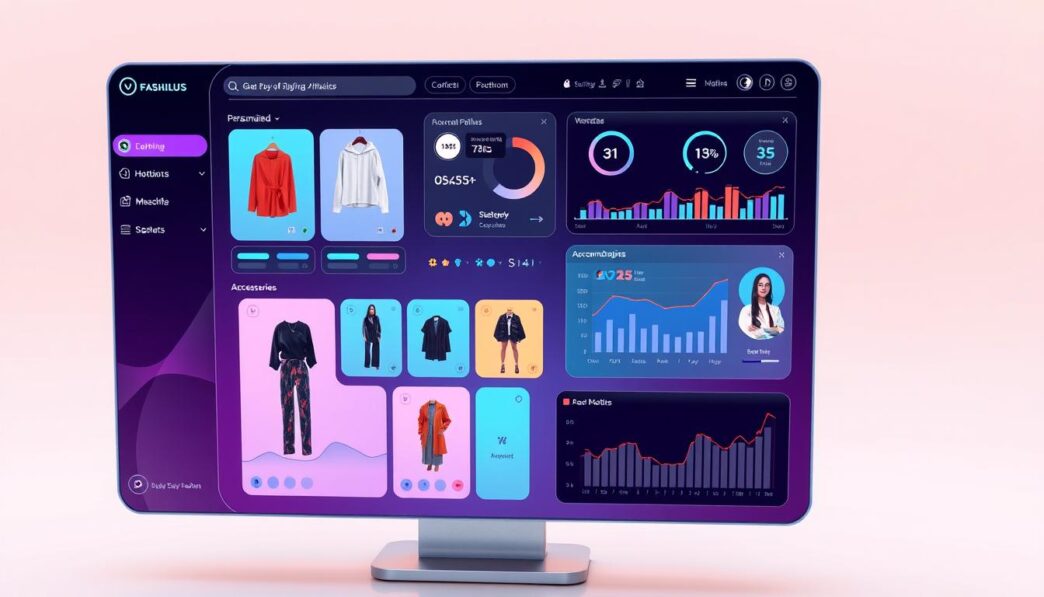Stitch Fix is changing the retail game by merging machine learning in fashion with a personalized touch. This blend transforms personalized fashion shopping. Here, AI fashion curation is key in providing services that truly get personal style. By using OpenAI, Stitch Fix analyzes a vast amount of customer info. This includes an incredible 4.5 billion text data points. This leads to spot-on styling suggestions for each customer.
At Stitch Fix, we use OpenAI embeddings and generative AI to turn feedback into real fashion picks. This combination of tech and personal insight makes our service feel uniquely tailored. It’s like having a friend who knows your style perfectly. The result? A service where every choice feels personal. My role combines AI fashion curation with human creativity for a unique experience.
Key Takeaways
- Stitch Fix uses AI to turn vast amounts of feedback into personalized styling options.
- Generative AI, powered by OpenAI, makes product descriptions and suggestions more effective.
- Innovative Outfit Creation Models allow for millions of customized daily outfit picks.
- AI helps create advertising content that is high-quality and effective, thanks to human review.
- Advances in algorithms predict sales, leading to better inventory and customer experiences.
- Stitch Fix leads in speed and scale in fashion retail with OpenAI’s GPT-3.
Introduction: Embracing Personalized Fashion with AI
Companies like Stitch Fix are leading the way in AI-driven fashion. They use AI to offer personal styling, changing how we buy clothes. With over 4.5 million active clients and tons of data, Stitch Fix is making fashion more personal than ever.
Stitch Fix deeply analyzes data from users about style, size, and life choices, thanks to its access to over 1000+ brands. This approach guarantees a unique shopping experience. It keeps customers coming back, boosting their bond with the brand.
AI-driven personal styling goes beyond current needs, aiming to foresee future desires. Stitch Fix optimizes shopping experiences with this tech, improving customer happiness and faithfulness.
- Over 3 million active users get daily personal “Fixes” matching their taste.
- The Outfit Creation Model (OCM) crafts 43 million new outfit combos every day, showing AI’s vast potential in fashion customization.
- In 2023, a record $1.6 billion revenue highlighted the economic boost from AI in fashion retail.
AI’s personal touch makes shopping not only easier but also smarter. Stitch Fix’s model lowers the chances of receiving unwanted items. This means fewer returns, tackling a big problem in online shopping.
“The future of fashion lies in personalization, and AI is the key to unlocking this potential,” says a Stitch Fix analyst.
| Brand | Key Improvement Area | Result |
|---|---|---|
| Tommy Hilfiger | Quick trend response | Expanded market reach |
| Adidas | Personalization in performance gear | Improved customer loyalty |
| The North Face | AI-based shopping assistant | Increased online sales and satisfaction |
| Levi’s | AI-driven demand forecasting | Reduction in unsold inventory |
| Myntra | Rapid design adaptation | Quick response to consumer trends |
Looking ahead, the mix of AI and human creativity will shift how we shop. AI in fashion isn’t just a tool, it’s a game-changer.
The Synergy of AI and Human Creativity in Stitch Fix’s Model
Stitch Fix stands at the crossroads of fashion and technology. It showcases how human-AI collaboration and machine learning make a great team. This approach doesn’t just make their process smoother. It also boosts the creative power of their stylists with AI.
Combining Expert Judgement with Machine Precision
Stitch Fix uses generative AI to turn client words into starting points for ads and item descriptions. This lets stylists use their creativity on harder tasks that need a human touch. AI in the early stages makes a strong foundation. Stylists then add personal touches that make each client’s experience unique.
Enhancing Stylist-Client Relationships Through AI
Stitch Fix uses smart analytics and personalization to turn complex data into simple insights. This makes it easier for stylists to get what each client wants. It leads to closer connections with clients. Stylists can then focus on making each client’s style unique, improving how clients feel about the service.
AI in Stitch Fix backs up stylists, not replaces them. It makes sure their choices are smart and focused on the client. This blend of AI and human creativity is what makes Stitch Fix special. It offers a personal styling experience that really hits the mark for each customer.

| Impact Area | Benefit |
|---|---|
| Revenue Growth | Companies excelling in personalization see up to 40% increase in revenue. |
| Customer Satisfaction | Enhanced through personalized interactions and precise style matching. |
| Operational Efficiency | Generative AI could add up to $275 billion to sector profits in near term. |
| Return Rates | Reduction in returns due to better tailored recommendations. |
This model shows how blending human skills with algorithms leads to great results. It means better numbers for the business and happier, loyal customers.
Understanding Client Style Through OpenAI Embeddings
In recent years, natural language processing in fashion and OpenAI GPT-4 have changed how brands meet style needs. Stitch Fix uses client style analysis with AI. This makes style picking more precise and scalable.
OpenAI GPT-4 lets Stitch Fix use client feedback in a big way. It turns words into data for fashion tips. This tech understands client talk, making sure tips match what clients want.
| Feature | Benefits |
|---|---|
| Client Feedback Interpretation | Enables personalized styling that reflects individual preferences |
| Scalability of Style Analysis | Processes large volumes of data, offering customized styling at scale |
| Integration with Fashion Trends | Aligns personal style insights with current fashion trends |
| Feedback Loop | Continuously refines style recommendations based on client interactions |
Using natural language processing in fashion with OpenAI GPT-4 gives companies like Stitch Fix an edge. They better understand what clients like. This leads to happier clients who stay longer. AI helps businesses offer tailored, engaging shopping experiences like never before.
Revolutionizing Advertising with AI-Generated Copy
The fashion world is changing with AI-generated advertising. Brands like Stitch Fix lead this change. They use GPT-3, a powerful AI, for marketing. This AI writes engaging ad copy that connects with people and boosts sales through personal messages.
How is AI changing fashion advertising? It analyzes lots of data like what customers like, fashion trends, and previous buys. Using this data, AI, especially GPT-3, makes ads. These ads are not just appealing but match what customers want and the latest in fashion. The quick use of GPT-3 for marketing lets businesses make better ad copy faster than people can.
Let’s look at how it works with Stitch Fix. They put fashion-related keywords into GPT-3. It then creates ad copy that’s more than descriptions. It tells a story, making customers interested in the clothes and the lifestyle they bring. Each ad is checked by people to keep the brand’s tone. This makes sure the ads are fast but still feel personal to customers.
AI-generated advertising is about more than just being quick. It aims to connect more deeply with consumers. The AI studies analytics to know what messages people like best. This makes ads more interesting and effective. Stitch Fix has seen better customer interaction and more sales, showing how powerful AI can be in creating engaging fashion stories.
In the end, GPT-3’s role in marketing is more than making text. It’s about really getting what consumers want and talking to them in a personal, thoughtful way. As AI gets better, we’ll see even more advanced ad strategies. These will continue to change digital marketing in exciting ways.
Streamlining Product Descriptions using GPT-3
AI advancements, especially with GPT-3, are changing how companies like Stitch Fix handle their content online. This AI use speeds up making product summaries that grab attention and give good info. GPT-3 helps Stitch Fix make thousands of product descriptions quickly. They make sure each piece of content fits the client’s personal style.
Creating Informative and Engaging Item Summaries
Stitch Fix uses GPT-3 to make product descriptions. This is a great example of AI in action. They can make about 10,000 unique product stories in just 30 minutes. They do this by using product data, customer feedback, and brand details. This creates content that’s not just a lot, but also personalized and fitting. It lets writers focus more on creative and important tasks.
The Impact of AI on Merchandising Efficiency
Stitch Fix uses AI to make their merchandising better. They have an expert-in-the-loop system. It makes sure the AI content is original, follows the brand, and is high quality. This system helps make the content better and better. It mixes algorithms with human ideas in a smart way. This is good for both the brand and its customers.

| Feature | Impact on Merchandising |
|---|---|
| GPT-3 Rapid Content Generation | Enables creation of 10,000 product descriptions in 30 mins |
| Expert-in-the-Loop Approach | Enhances content quality and ensures brand consistency |
| Customer Data Utilization | Generates personalized content based on unique customer profiles |
With these new ideas, Stitch Fix makes managing merchandise smoother. It also improves how they work and makes customers happier. Using GPT-3 and AI insights keeps the company ahead in the quick-moving fashion world.
Innovative Outfit Assembly with the Outfit Creation Model
The world of retail has changed, thanks to fashion personalization technology. Brands like Stitch Fix are at the heart of this change. They use the Stitch Fix Outfit Creation Model (OCM) to make styling options. These are based on what each client likes and how they live.
Training Models on Stylist-Created Outfits
Stitch Fix does more than just use algorithms for outfit assembly. They bring real stylistic knowledge into the outfit creation AI. The system is trained on outfits picked by professional stylists. This way, it learns the fine details of personal style. This method ensures the suggested outfits truly match individual preferences.
Personalizing Fashion at Scale
Fashion personalization technology shines when it personalizes on a big scale. Stitch Fix’s AI looks at what they have and what clients have liked before. It then suggests new outfits. This used to be something only personal stylists for the rich could do. Now, AI makes it available to all.
The table below shows how Stitch Fix’s approach differs from other AI fashion services. It shows the importance of using personalized data and deep learning. This improves customer happiness and involvement:
| Feature | Stitch Fix | Other AI Services |
|---|---|---|
| Data Utilization for Outfit Assembly | Highly personalized, uses historical data extensively | Standardized, less customization |
| Integration of Stylist Input | Fully integrated with human stylist insights | Minimal or none |
| Scale of Personalization | Mass personalization, individual user level | Generalized, segment level |
| Feedback Mechanism | Dynamic, real-time adjustments based on feedback | Static, slow updates |
| Technological Advancements | Leading in employing new AI innovations | Follows established AI applications |
Through combining AI with expert human input, Stitch Fix leads in outfit creation AI. They also pave the way in making fashion more personal for everyone.
Conclusion: The Fashionable Future of AI and Personalization
Stitch Fix’s journey into AI and data science shows a promising future for AI in fashion. The brand smartly combines advanced fashion tech with expert stylists’ insights. This approach serves 3.9 million clients, showcasing a path for the fashion world. By blending AI-driven personalization with creative human input, Stitch Fix meets diverse customer styles from a selection of a thousand brands.
Customers offer 90 data points that fuel an algorithm, creating tailor-made collections. With this data, stylists get a ranked list of choices that seem perfect for each person. This method helped Stitch Fix achieve $1.7 billion in sales. It places Stitch Fix as a leader in AI-driven personalization, setting a standard for digital retail.
AI is reshaping the fashion industry, aiming for $275 billion in profits by making shopping personal. With more people, especially millennials, shopping online, the need for cutting-edge fashion tech grows. Stitch Fix uses over 4.5 billion data points to make shopping very personal. This could lead to a 40% revenue increase for companies focusing on personalization. In a $2.2 trillion industry, AI’s role in blending technology with tradition will make fashion both personal and forward-looking.




















